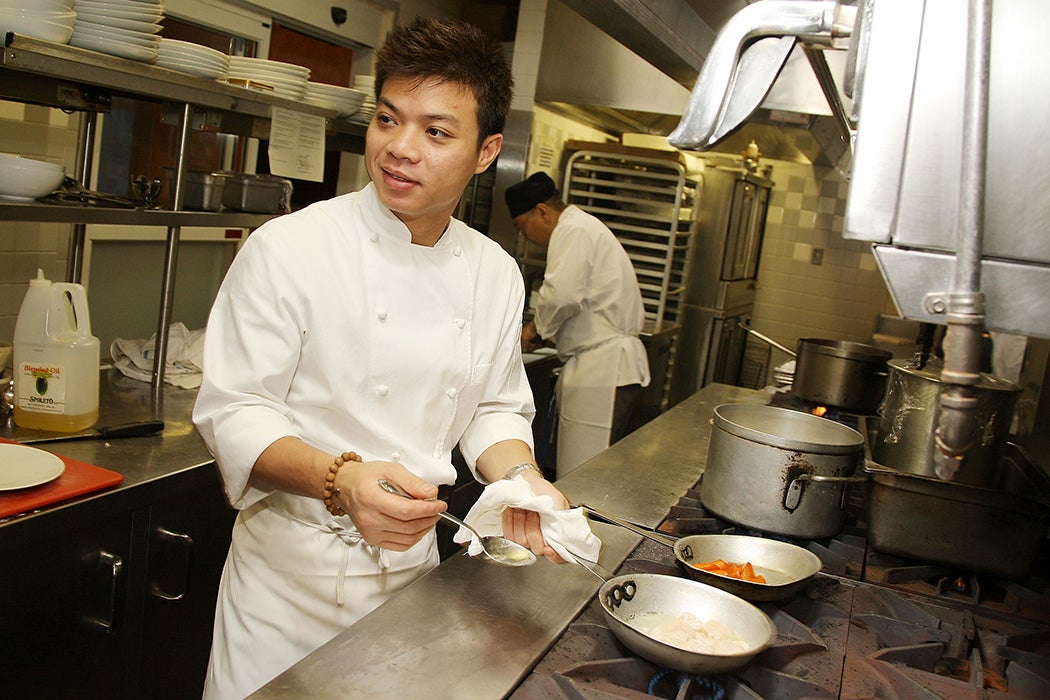Let the best chef win! Isn’t that the point of the “theoretically unscripted” televised cooking contest? With Top Chef now in its twentieth season, that promise seems to remain as compelling as ever to fans. Yet participants may discover that it’s not just cooking chops that propel them to victory. They must sell their own life stories, too—sometimes along racial lines, as Timothy August argues, in a revisit of season three.
That season saw contestant Hung Huynh emerge as the first Asian American champion on Top Chef. But before he became crowned the winner, he had to face critical comments from judges who seemed to fixate on his Vietnamese heritage. In the penultimate episode, for instance, one judge tells him, “You were born in Vietnam…I don’t see any of that in your food.”
After receiving this feedback, “Hung figures out how to win this game pretty quickly,” according to August, who uses the name Hung to refer to Huynh’s persona as a contestant on the show. Rattling off a list of relatives from his mother to his cousins’ cousins, Hung announces to the judges that his passion for cooking can be attributed to the culinary inspiration of “my whole family” and “bloodline.”
“Through the smiles, nods of the judges and fellow contestants, and swelling music, we are told that Hung has produced and hit the mark with his storytelling,” August recounts. “He has produced a narrative that successfully integrates his Vietnamese-ness within the aesthetic criteria of the judging order.”
For August, this episode is an example of how Asian Americans must navigate “an entrenched readership that demands a certain narrative” when it comes to their relationship with food. In Hung’s case, the expectation is for a Vietnamese American chef to “not only look the part but also perform his ethnicity through his food”—a demand that August argues is not made of the other contestants.
Hung’s response is a savvy move, showing that he “knows how to select the details of selflessness, family, and hard work that elide his supposedly traditional background along with American liberal values.”
But Asian Americans may also work to subvert the expectation that their food habits reveal a foreign quality. August analyzes Hung’s storytelling in tandem with Bich Minh Nguyen’s book Stealing Buddha’s Dinner, which also centers on Vietnamese American family ties to food. Where Hung “recognized and reacted to the familiar interviewer/respondent relationship and understood the narrative that was needed to win the competition,” Nguyen uses her writing to sidestep the dominant culture’s insistence on defining Vietnamese American stories through refugee histories.
Weekly Newsletter
By focusing on her childhood fascination with commodities such as Big Macs, Nguyen’s memoir instead identifies consumer products as objects “through which whiteness was conceived and promoted,” writes August. Fighting the stereotype that minority narratives are all the same, August argues that Huynh and Nguyen’s different “social performances” together show the multiple cultural meanings that food can hold.
“We must be wary of a simple conflation of culture and cuisine and produce close readings that historicize the way that Asian Americans and what stands for their cuisine continue to signify in this country,” August concludes. Huynh and Nguyen’s social performances constitute “important aesthetic battlegrounds, where the fight is not to announce who Vietnamese Americans are, but, like the ingredients of a dish, what will be made of them.”







